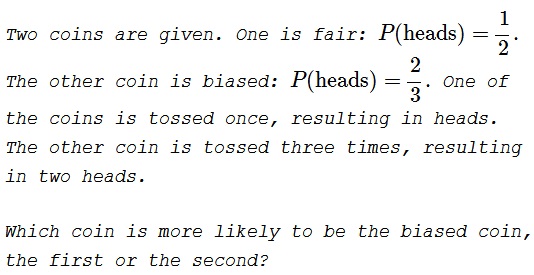Two Coins: One Fair, one Biased
Problem

Solution 1
Assuming the fair coin is the one that was tossed, then the probability of it showing heads and of the other coin showing two heads is given by
$\displaystyle \frac{1}{2}\cdot{3\choose 2}\left(\frac{2}{3}\right)^2\left(\frac{1}{3}\right)^{1}=\frac{2}{9}.$
On the other hand, if the biased coin was tossed once then the probability of the observed result is
$\displaystyle \frac{2}{3}\cdot{3\choose 2}\left(\frac{1}{2}\right)^2\left(\frac{1}{2}\right)^{1}=\frac{2}{8},$
telling us that more likely it was the biased coin that was tossed once.
Solution 2
Without any a-priori knowledge, let us assume that the first coin is equally likely to be either of the two coins. Let $D$ denote the observation and $B$ the event that the first coin is biased. Thus, $P(B)=P(\overline{B})=1/2$,
$\displaystyle\begin{align} P(D|B)&=\left[\frac{2}{3}\right]\cdot \left[C(3,2)\left(\frac{1}{2}\right)^2\left(\frac{1}{2}\right)\right]=\frac{1}{4}, \\ P(D|\overline{B})&=\left[\frac{1}{2}\right]\cdot \left[C(3,2)\left(\frac{2}{3}\right)^2\left(\frac{1}{3}\right)\right]=\frac{2}{9}. \end{align}$
Using Bayes theorem,
$\displaystyle\begin{align} P(B|D)&=\frac{P(D|B)P(B)}{P(D|B)P(B)+P(D|\overline{B})P(\overline{B})} \\ &=\frac{1/4}{1/4+2/9}=\frac{9}{17}>\frac{1}{2}. \end{align}$
Thus, the observation makes the first coin more likely to be biased.
Solution 3
Prior (relative) odds are even, while likelihood ratio is
$\displaystyle\begin{align} LR&=\frac{Pr(E|B,F)}{Pr(E| F,B)}= \frac{\displaystyle\frac{2}{3}\cdot\left(\frac{1}{2}\right)^3}{\displaystyle\frac{1}{2}\cdot\left(\frac{2}{3}\right)^2\cdot\frac{1}{3}}= \frac{\displaystyle\frac{2}{3}\cdot\frac{1}{8}}{\displaystyle\frac{1}{2}\cdot\frac{4}{27}}\\ &= \frac{9}{8}. \end{align}$
Odds in favor of the first coin being biased and the second coin being fair are $9:8,$ i.e. $\displaystyle prob=\frac{9}{17}.$
Acknowledgment
This is problem 1989-4 from the A Friendly Mathematics Competition by Rick Gillman (ed.)
Solution 2 is by Amit Itagi; Solution 3 is by Joshua B. Miller.
|Contact| |Front page| |Contents| |Probability|
Copyright © 1996-2018 Alexander Bogomolny73602095
